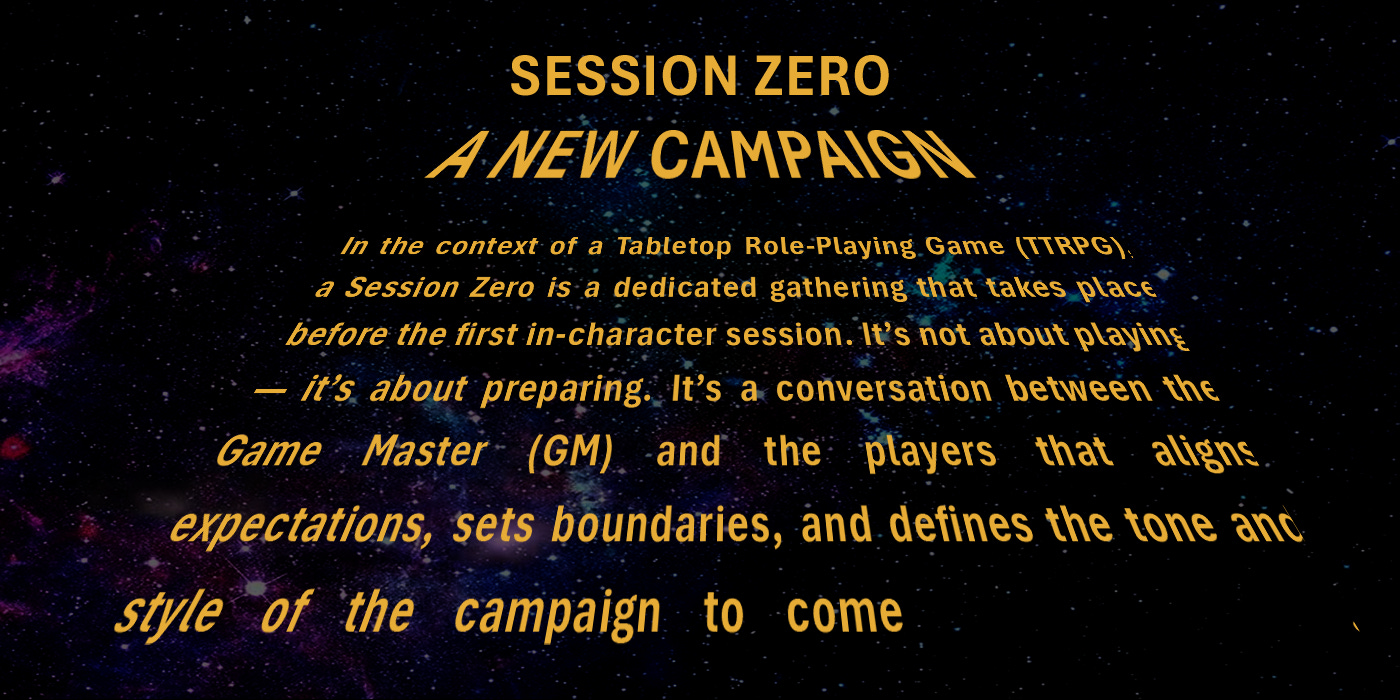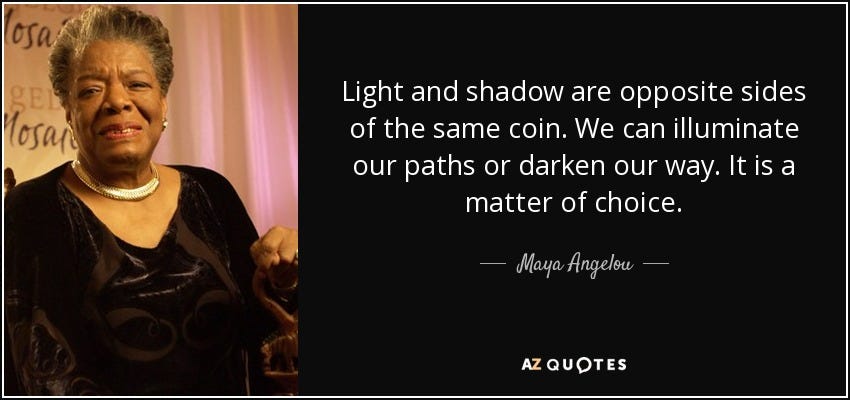What is Session Zero and why should it be the first thing you do at the beginning of every campaign?
How setting expectations early can make your tabletop game safer, smoother, and far more satisfying.
What is a Session Zero?
In the context of a Tabletop Role-Playing Game (TTRPG), a Session Zero is a dedicated gathering that takes place before the first in-character session. It’s not about playing — it’s about preparing. It’s a conversation between the Game Master (GM) and the players that aligns expectations, sets boundaries, and defines the tone and style of the campaign to come.
Key aspects often covered in a session zero include:
Campaign Premise: The GM introduces the concept, themes, setting, and intended scope of the game.
Player Expectations: Players share what they’re excited for — role-play, exploration, combat, narrative arcs, and more.
Rules and Mechanics: Clarify which system you’re using, any house rules, and how disagreements will be handled.
Character Creation: Discuss character ideas, party cohesion, and whether to create together or separately.
Safety Tools and Boundaries: Define what topics are off-limits (lines), which should be handled with care (veils), and what tools like the X-card are available to signal discomfort.
Logistics: Agree on session frequency, communication channels, attendance expectations, and technology use at the table.
At its core, Session Zero is about one thing: shared understanding. By laying the groundwork upfront, you reduce the chance of misunderstandings and increase the likelihood of a truly collaborative and enjoyable campaign.
The Question That Matters
Now that we’ve defined what a Session Zero includes, let’s ask the big one: Do you need it for your group? The short answer is: yes, probably. But there’s more to it than that.
Even groups who’ve been together for years benefit from re-calibrating. A new campaign isn’t just a continuation — it’s a new story. New characters, new emotional stakes, and often a new tone or genre. That means new conversations need to happen.
Session Zero isn’t about fixing problems — it’s about preventing them.
It’s not a patch. It’s a foundation.
It’s also not just for “problem players” or first-time GMs. It’s for anyone who wants their campaign to run on trust, clarity, and enthusiasm — rather than on assumption and improvisation of expectations.
The truth is, even well-meaning players can make missteps when they’re unclear about what kind of game they’re playing. Maybe one player thinks it’s a high-fantasy epic while another assumes a low-comedy romp. Or maybe the GM is planning a horror-tinged tragedy, and no one else is emotionally prepared.
Session Zero is where you catch that misalignment before it becomes friction. It’s also where you create a culture of openness that invites feedback and trust — and lets your players know they can bring concerns to you without fear or friction.
Session Zero: More Than Just Logistics
This initial session aims to foster trust between the players and the Game Master, as well as among the players themselves. By discussing key aspects of the upcoming campaign, everyone becomes better informed about the tone, themes, and expectations at the table. Players can ask questions about which ruleset(s) will be used and whether homebrew elements are allowed, or if the campaign will be played strictly “Rules as Written” (RAW).
It’s also an opportunity to clarify group dynamics: is this an all-for-one party where cooperation is the default, or will it allow for everybody-for-themselves play and character-vs-character (CvC) conflict? Players can also align on the expected level of roleplay versus combat, and how much narrative emphasis will be placed on either.
Session Zero is also where the group lays out the real-world logistics. Scheduling concerns, player commitment, and distraction policies (device use, necessary apps, texting etiquette) can be discussed openly. House rules for table etiquette—both in and out of character—can be set clearly, preventing misunderstandings later.
Finally, and perhaps most importantly, it’s the time to discuss content boundaries—the themes, topics, or tones that might be uncomfortable or off-limits. This is where tools like lines (hard no’s) and veils come into play. A veil means that the content may exist in the story’s world, but the table agrees not to describe it in detail. Instead, the moment is summarized or skipped over with a “fade-to-black”—a narrative technique, borrowed from film, where something is implied but not shown. For example, a scene involving intimacy, torture, or trauma might be acknowledged, but not roleplayed out in full detail.
These tools aren’t about restricting creativity—they’re about protecting player engagement. Comfort levels vary wildly. What’s fun for one might be deeply uncomfortable for another. By addressing those boundaries up front, you create a space where everyone can participate more freely, and with more trust. Session Zero doesn’t limit your story—it expands what’s possible.
Centering the Experience by Opening the Story’s Door
The expectation for any session is simple: that everyone enjoys the experience. But that doesn’t happen by default — it takes intention. That means acknowledging the players’ investment in the game: their time, their characters, and most importantly, their role in shaping the story.
Too often, campaigns are treated as the Game Master’s world that players get to visit. But the truth is, players don’t just enter the story — they expand it. They fill in emotional beats, create tension and levity, and explore parts of the world the GM might never have planned. A great campaign isn’t just written — it’s discovered together.
Session Zero is the first step in setting up that collaboration. It’s where you make space for players to express what excites them, what matters to them, and how they imagine participating in the tale. Are they looking for heroic arcs? Slow-burn romances? Inner conflict? Tactical brilliance? Knowing these things helps the GM build a campaign scaffold that invites player creativity — not just accommodates it.
This is especially powerful for sandbox GMs, who thrive on player-driven direction. When players are encouraged to share their goals and boundaries up front, the GM gains a wealth of story hooks, potential conflicts, and themes to weave into the world. The campaign becomes less about steering players through a plot and more about curating a responsive, living setting — one that evolves naturally from the players’ choices.
Centering the player experience doesn’t mean handing over the reins — it means building the road together. It’s how good stories become great ones. And it starts with listening.
Safe Spaces Are Intentional Spaces
When a group of players gathers — including the Game Master — the intent is simple: to have fun, enjoy each other’s company, and share in the experience of the game. In other words, the event should be a safe space for everyone at the table. Even the GM.
But while the idea of a safe space sounds natural, it takes conscious effort to create and reinforce. Safety doesn’t just happen — it’s built. And thankfully, there are tools that can help the GM and players maintain that space, even allowing for anonymous or subtle communication when needed.
Some helpful tools include:
X-card – A physical or virtual card that any player can tap to immediately pause or skip the current scene.
Traffic light system – Players indicate comfort levels with green (all good), yellow (caution), or red (stop) signals, which can be shown physically or online.
Post-game cool-downs – A short debrief after the session to talk through highlights, discomforts, or any lingering thoughts.
Just as important as these tools is normalizing discussions about discomfort and personal preferences. It’s not always easy to speak up, especially in a group where not everyone knows each other well. That’s why it’s so important to make these conversations part of the culture — not an exception, but an expectation.
Once players feel safe to engage fully, the storytelling opens up. Roleplay becomes richer. Emotional investment deepens. Without that sense of safety, creativity gets caged — limited by hesitation, fear, or doubt.
Developing a method of trust allows players to bring up problems without hesitation. That trust starts with you, the GM, being open, responsive, and nonjudgmental.
Because when people feel secure, they play boldly. And bold play makes for unforgettable stories.
The Evolving Session Zero
The end of one story brings the beginning of another — and with it, the return of a vital ritual: Session Zero.
Even when the players haven’t changed and the Game Master remains the same, a new campaign brings a new tone, new goals, and new dynamics. This is true even when the setting remains familiar. A different story shifts how the table functions, and that shift deserves attention.
Session Zero gives the group a chance to re-calibrate — to talk about tone, explore new characters, reflect on past habits, and set fresh expectations. It’s a way to clear the narrative slate without discarding the shared trust you've already built.
By taking this time again, you head off future frustration and give the next campaign a strong foundation. And over time, this process becomes part of your table’s rhythm — not a chore, but a custom. A ritual. Eventually, your players will expect it. They might even look forward to it.
Because every story deserves a good beginning. And this is how you build one — together.
A Table Built on Trust Rolls Better
Session Zero is a gift — a moment that brightens and enhances everything that follows. It isn't a hurdle, a checklist, or a maze of red tape. And it’s certainly not a mechanism to control your players.
No — it’s an invitation. It’s about informed consent. About welcoming your players into the story not just as participants, but as partners.
Sure, the fickle dice gods don’t care how aligned your group is. A natural 1 still stings. But somehow… when your table is built on trust, even failure feels more fun. The laughter comes easier. The drama hits harder. The story carries weight — because everyone helped build it.
That’s the true magic of Session Zero. Not in the tools or the rules, but in the trust it fosters. The kind of trust that lets players take creative risks. That allows characters to be vulnerable. That empowers the table to chase something unforgettable together.
Session Zero doesn’t control the dice. But it does make every roll mean more.
Light and shadow are opposite sides of the same coin. We can illuminate our paths or darken our way. It is a matter of choice. - Maya Angelou



